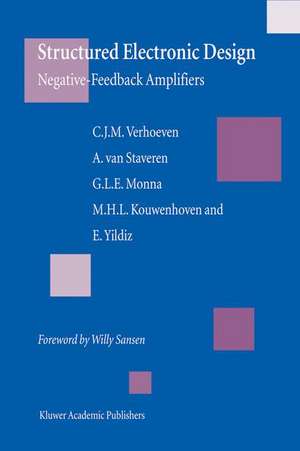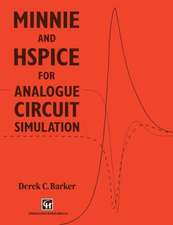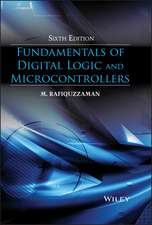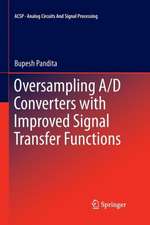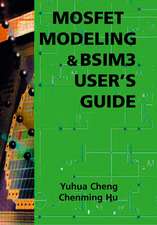Structured Electronic Design: Negative-feedback amplifiers
Autor Chris J.M. Verhoeven, Arie van Staveren, G.L.E. Monna, M.H.L. Kouwenhoven, E. Yildizen Limba Engleză Hardback – 31 oct 2003
Structured Electronic Design: Negative-Feedback Amplifiers presents a design methodology for negative-feedback amplifiers. The design methodology enables to synthesize a topology and to, at the same time, optimize the performance of that topology.
Key issues in the design methodology are orthogonalization, hierarchy and simple models. Orthogonalization enables the separate optimization of the three fundamental quality aspects: noise, distortion and bandwidth. Hierarchy ensures that the right decisions are made at the correct level of abstraction. The use of simple models, results in simple calculations yielding maximum-performance indicators that can be used to reject wrong circuits relatively fast.
The presented design methodology divides the design of negative-feedback amplifiers in six independent steps. In the first two steps, the feedback network is designed. During those design steps, the active part is assumed to be a nullor, i.e. the performance with respect to noise, distortion and bandwidth is still ideal.
In the subsequent four steps, an implementation for the active part is synthesized. During those four steps the topology of the active part is synthesized such that optimum performance is obtained. Firstly, the input stage is designed with respect to noise performance. Secondly, the output stage is designed with respect to clipping distortion. Thirdly, the bandwidth performance is designed, which may require the addition of an additional amplifying stage. Finally, the biasing circuitry for biasing the amplifying stages is designed.
By dividing the design in independent design steps, the total global optimization is reduced to several local optimizations. By the specific sequence of the design steps, it is assured that the local optimizations yield a circuit that is close to the global optimum. On top of that, because of the separate dedicated optimizations, the resource use, like power, is tracked clearly.
Structured Electronic Design: Negative-Feedback Amplifiers presents in two chapters the background and an overview of the design methodology. Whereafter, in six chapters the separate design steps are treated with great detail. Each chapter comprises several exercises. An additional chapter is dedicated to how to design current sources and voltage source, which are required for the biasing. The final chapter in the book is dedicated to a thoroughly described design example, showing clearly the benefits of the design methodology.
In short, this book is valuable for M.Sc.-curriculum Electrical Engineering students, and of course, for researchers and designers who want to structure their knowledge about analog design further.
| Toate formatele și edițiile | Preț | Express |
|---|---|---|
| Paperback (1) | 868.19 lei 6-8 săpt. | |
| Springer Us – 5 noi 2010 | 868.19 lei 6-8 săpt. | |
| Hardback (1) | 874.79 lei 6-8 săpt. | |
| Springer Us – 31 oct 2003 | 874.79 lei 6-8 săpt. |
Preț: 874.79 lei
Preț vechi: 1066.81 lei
-18% Nou
Puncte Express: 1312
Preț estimativ în valută:
167.41€ • 176.11$ • 139.69£
167.41€ • 176.11$ • 139.69£
Carte tipărită la comandă
Livrare economică 09-23 ianuarie 25
Preluare comenzi: 021 569.72.76
Specificații
ISBN-13: 9781402075902
ISBN-10: 1402075901
Pagini: 380
Ilustrații: XV, 358 p.
Dimensiuni: 155 x 235 x 26 mm
Greutate: 0.72 kg
Ediția:2003
Editura: Springer Us
Colecția Springer
Locul publicării:New York, NY, United States
ISBN-10: 1402075901
Pagini: 380
Ilustrații: XV, 358 p.
Dimensiuni: 155 x 235 x 26 mm
Greutate: 0.72 kg
Ediția:2003
Editura: Springer Us
Colecția Springer
Locul publicării:New York, NY, United States
Public țintă
GraduateCuprins
to Structured Electronic Design.- Synthesis of Accurate Amplifiers.- Negative Feedback.- Noise.- Nonlinear Distortion.- The Loop-Gain-Poles Product.- Frequency Compensation.- Biasing.- DC Sources.- Design Example.
Recenzii
From the reviews of the first edition:
"The book provides an original and novel approach to electronic design, more specifically a global and structured one. We think the book is a real contribution to the electronic design theory and will soon become a reference book in the domain." (Dumotru Stanomir, Zentralblatt MATH, Vol. 1053 (4), 2005)
"The book provides an original and novel approach to electronic design, more specifically a global and structured one. We think the book is a real contribution to the electronic design theory and will soon become a reference book in the domain." (Dumotru Stanomir, Zentralblatt MATH, Vol. 1053 (4), 2005)
